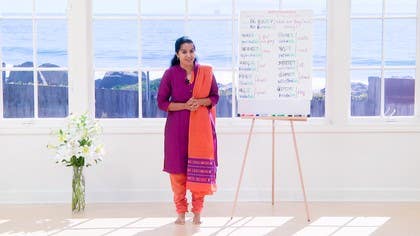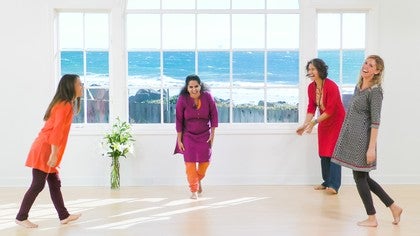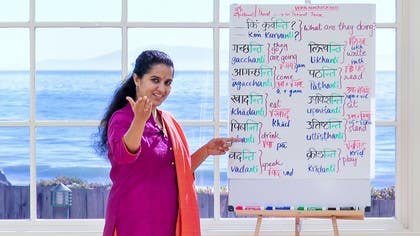Description
About This Video
Transcript
Read Full Transcript
Harihi Om and Namaste. So Harihi Om is another popular greeting when people meet each other. So my friends, I hope you've been working hard because there is a little work. Any language that you learn, you cannot escape a little bit of homework. But the more you do it, the easier it will get.
So here we are. We've looked at the 10 simple verbs in Sanskrit. And then we saw what they looked like. We saw it in our previous session for the third person singular and also for the second person formal which uses the same word form which is tea. So gachati saha he gachati alana gachati sa she gachati fortunately it's gachati.
And then you have for the formal you bhavan or bhavati is also gachati. You would recognize the third person singular and the second person singular formal with the ending tea gachati kadati patati vadati. Got the rhythm? Okay. So now we move on to learning a new rhythm.
And this is when we have two people doing an action. Those two doing the action. So the question for that is kim kuru taha. We've already seen, we had our friends Alana and Nicole demonstrated for us. In this particular section we will look at what the script of those sounds appear to be.
So here we are. We have kim kuru taha. What are those two doing? Kim what kuru taha? They are going gachata ha gachata ha.
They are coming aagachata ha aagachata ha. I hope you are paying close attention to the ending of the verb. That is going to give you a clue on who is performing the action and how many of them. So gachata ha aagachata ha. In our last session we also tried to start identifying a few roots of Sanskrit verbs.
So with gachata ha the root was gum. And in the transliteration, gum. So gachata ha comes from the root gum. Alright there is a hardware behind that, don't worry. Just know that the root of gachata ha is the verb gum.
Aagachata ha has the prefix aa to it. So we have aa plus the root gum. Right. I will start dropping writing the transliteration at time so that you get familiar with the Sanskrit letters. The next verb is kada taha.
Two of them so kada taha, kada taha. You have got the rhythm now. The ending has to be taha. The root of kada taha is khad, khad, I will write it for you, khad, lovely. So peebatthi will be peebatthaha, very good peebatthaha, peebatthaha, very nice.
The root of peebatthaha is fa. The root of many verbs is simple to identify but sometimes it does something strange. So vada taha, they to speak, so vada taha, say that, vada taha, very nice. Vada taha, vada taha. The root of that is a simple one so it would be vada.
Great. Next writes, lika taha, they to write, lika taha, lika taha, lika taha. Very good. Do you remember the verb form, the root form, yeah, lika. So many of these are simple except for this one.
So it's the simple root form, so it's lika. And in transliteration, lika, there we go. To read, vada taha, they to read, vada taha. Like we've mentioned it earlier, even the u formal takes on the same form. So the two of you formal, vada taha, all right.
So that is how it is written, vada taha, it's the full tomato. So a lot of energy into it, pa, taha, taha, pa, taha, taha. The root of that is again simple, so it's paat, paat, all right. Then the verb to sit, two of them sitting, upa, visha, taha, do that, upa, visha, taha. The two of them, upa, visha, taha, fantastic.
And that is what it looks like, upa, visha, taha, upa, visha, taha, and to sit. And you remember when we spoke about it in the singular, we mentioned that there is a prefix upa, so it is upa plus the verb vish, upa plus vish, there we are. The opposite to stand up, those two stand, uttish, tah, taha, uttish, tah, taha, uttish, do you hear that slight tah, tah. So that's why you know there are two T's in there, uttish, tah, tah, uttish, tah, tah, lovely. The root for this is a little more hard, it's the one like in English you have the word unstabilized, tah, that kind of a sound, so it's sthah, sthah.
We have the prefix utt to say upward and then the root sthah. You'll actually be surprised to discover how much of Sanskrit there is in English. So we'll try and awaken the English language through this, through our exercises at times to its Sanskrit origins and try and play with that as well. Alright, here we have utt plus tah in transliteration, sthah, lovely. And the fun word, day to play, creedah, tah, creedah, tah, say that creedah, tah, very good and when you look at it creedah, tah, creedah, tah, lovely.
The root is a simple one, so it's creedah and the transliteration. You see the English language was taking a little bit of revenge on me, I just said that we'll play with the English language, well it took me for a ride this time. So instead of writing the Sanskrit, I ended up writing it in transliteration both times. So we'll just cover that up and do it in Sanskrit, so it's creedah, that's it, yeah. So join me in repeating each of these verbs, I'll say it once and then you repeat it and in your mind think of the action as well because that would help to let that word be embodied in your system.
So what are those two doing or what are you two formal doing, kim kuru tah, kim kuru tah, lovely. They too are going, gachatah, gachatah. You'll notice that when I'm saying they too are going in the English language, I'm giving you the pronoun, but when I'm doing it in Sanskrit, I'm leaving the pronoun out and just saying gachatah, that is because the ending is self-sufficient. It tells me by itself that there are two people who are going. Now contextually, I would need to understand whether it's two men going, two ladies going, two neuter things going or whether it's two you formal going, kadar.
But just tah is actually enough, I don't even need to say they too, right? So I'll give you the English and then we'll just say the Sanskrit ones, right? So they too go, gachatah, gachatah, they too come, agachatah, fantastic. They too eat, kadah, tah, lovely. They too drink, peebah, tah, tah, lovely, they too speak, vada, tah, very nice.
They too write, likah, tah, they too read, patah, tah, very nice. They too sit, upa, vishat, tah, lovely, very good. They too stand, uttish, tah, tah, uttish, tah, fantastic. And finally, they too play, kreed, tah, super. So practice, play and you will learn.
And see you again in the next session to practice the third person plural with these verbs. Namaste.







You need to be a subscriber to post a comment.
Please Log In or Create an Account to start your free trial.